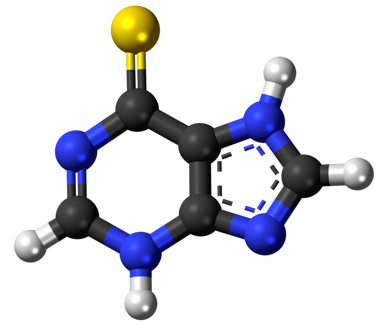Genetic Variant Affects Treatment Intolerance in Pediatric ALL
Using genome-wide association studies, researchers have identified a germline variant that is associated with intolerance to mercaptopurine in pediatric ALL.
Ball-and-stick model of mercaptopurine

Using genome-wide association studies researchers have identified a germline variant, NUDT15, that is strongly associated with intolerance to mercaptopurine in children with acute lymphoblastic leukemia (ALL), according to a study published recently in the Journal of Clinical Oncology.
“We took an agnostic approach to systematically evaluate germline SNPs for their association with mercaptopurine dose intensity during maintenance ALL therapy,” wrote Jun J. Yang, PhD, of St. Jude Children’s Research Hospital, and colleagues. “We confirmed that variants in TPMT were the strongest predictor of mercaptopurine tolerance but importantly described NUDT15 as another critical locus associated with susceptibility to mercaptopurine intolerance resulting from excessive toxicity.”
Yang and colleagues conducted genome-wide association studies in 657 children who were enrolled in the Children’s Oncology Group AALL03N1 trial. A replication study was carried out in 371 children from the St. Jude Children’s Research Hospital Total Therapy XV protocol. The researchers calculated tolerance to mercaptopurine dose through dose intensity, defined as prescribed dose divided by the planned protocol dose during maintenance therapy.
The researchers found that dose intensity varied greatly by race/ethnicity. Specifically, they found that patients with East Asian genetic ancestry had a negative correlation with mercaptopurine dose intensity (P < .001). The genome-wide association studies revealed two genome-wide loci significantly associated with dose intensity: rs1142345 in TPMT (P = 8.6 × 10-9) and rs116855232 in NUDT15 (P = 8.8 × 10-9), with independent replication.
Results showed that those patients with TT genotype at rs116855232 had an average dose intensity of 8.3% compared with TC genotypes and an average dose intensity of 63% and CC genotypes with an average dose intensity of 83.5%.
Supporting the earlier finding, the NUDT15 variant was found most commonly in patients of East Asian and Hispanic ethnicity, and was rare in Europeans.
“Although the higher prevalence of NUDT15 variant in East Asians may have contributed to over-representation of mercaptopurine intolerance in this population, we also acknowledge that our statistical power was limited by the relatively small number of East Asian patients included in this study,” the researchers wrote. “In addition, East Asian genetic ancestry remained associated with mercaptopurine dose intensity after adjusting for rs166855232, suggesting the existence of other Asian-specific factors related to mercaptopurine sensitivity.”
Finally, the researchers looked at mercaptopurine tolerance in children with both TPMT and NUDT15 variants. Children homozygous for either variant or heterozygous for both, 100% required at least a 50% reduction in mercaptopurine dose compared with only 7.7% of other children.
“Finally, 5.7% of patients who required > 50% mercaptopurine dose reduction were wild type for both TPMT and NUDT15 variants, and therefore, other genetic and nongenetic factors are still to be discovered to further improve mercaptopurine dose individualization in children with ALL,” the researchers wrote.